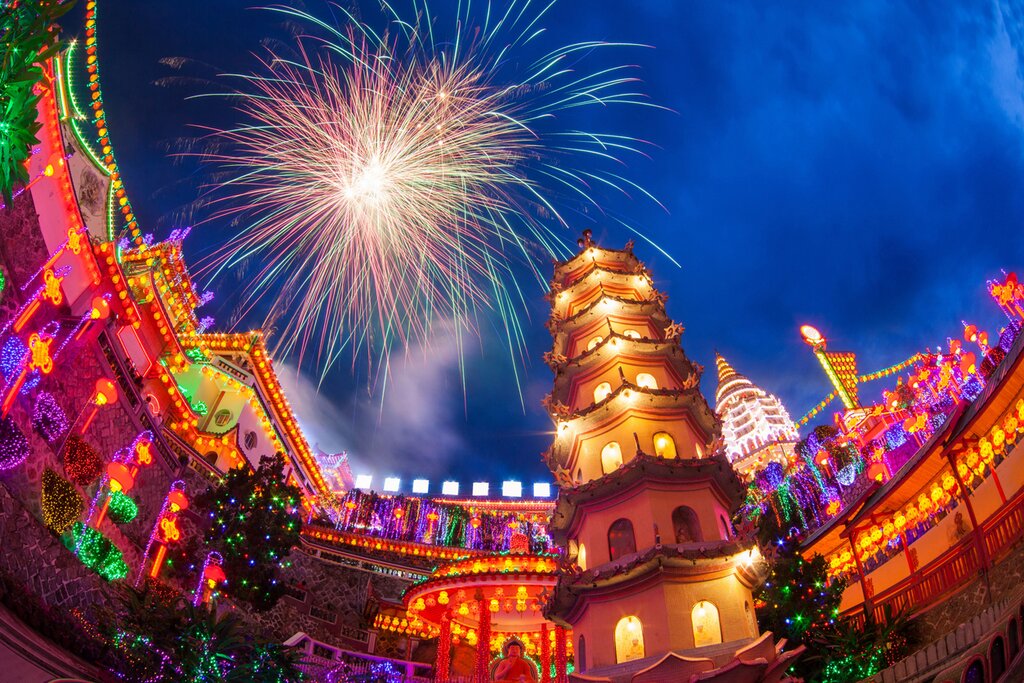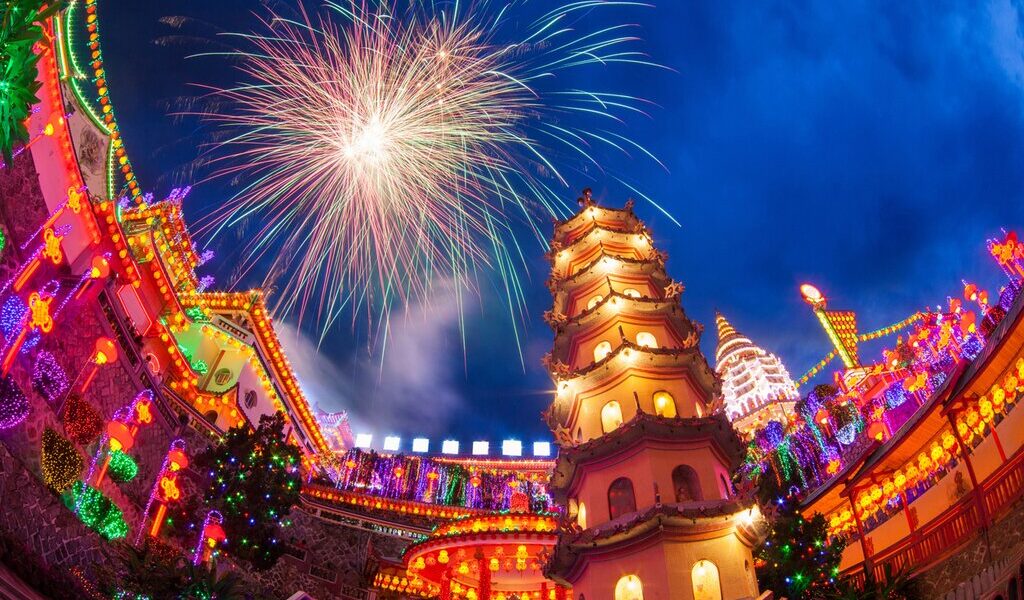
February is peak season for travel to Malaysia’s west, particularly Kuala Lumpur, Penang, Melaka, and Langkawi. The weather is clear, and there’s little rain, making it a great time to enjoy time on the beach, city sightseeing, and some lively cultural festivals. Find out more about where to go and what to do in Malaysia in February below.
Weather in Malaysia
Malaysia, a captivating tropical nation, stretches across a diverse geographical area. While temperatures remain remarkably consistent throughout the year and across different regions, the rainfall patterns exhibit considerable variation. It’s quite common to find one part of the country basking in sunshine while another is experiencing a downpour. Generally speaking, Malaysia experiences two primary seasons: the wet season and the dry season. However, it’s important to note that these seasons do not arrive simultaneously across the entire country. The temperature range is quite stable, generally hovering between a comfortable 71°F (22°C) and a balmy 91°F (33°C) throughout the year. Locations situated at higher altitudes tend to enjoy cooler temperatures, providing a welcome respite from the tropical heat.
February is often mentioned as a drier month in Malaysia, sometimes even referred to as the “winter” period. However, it’s essential to remember that Malaysia is a tropical country, and the concept of winter doesn’t quite align with the reality here. In popular destinations such as Kuala Lumpur, Penang, Melaka, and Langkawi, which are all situated on the western side of Peninsula Malaysia, February tends to be relatively dry. Nevertheless, visitors should still be prepared for the possibility of encountering some rainfall. Conversely, the northeastern coast of the peninsula, the eastern islands (including the well-loved Perhentian Islands), and the western coast of Sarawak (Malaysian Borneo) experience wetter conditions in February, often drenched by the northeast monsoon. The interplay of these weather patterns creates a diverse climate landscape across the country.
Crowds and Costs During February
February falls within the peak tourist season for the western regions of Malaysia, particularly in Langkawi, which is a highly sought-after beach destination. Several significant festivals may occur in February, including the vibrant Lunar New Year and the captivating Thaipusam festival. These festivals attract large crowds to numerous locations, especially to the bustling cities of Kuala Lumpur and Penang. Consequently, hotel prices in these popular western areas tend to be higher in February compared to the wet season. On the other hand, you won’t encounter peak-season accommodation prices in Borneo during this time, but the persistent heavy rainfall can make it a less appealing period to plan a visit. Therefore, it’s essential to consider your priorities and preferences when deciding on the best time to travel to Malaysia.
Recommended Destinations in February
Given the generally favorable weather conditions in western Malaysia during February, it is advisable to concentrate your travels on these areas of Peninsular Malaysia. Consider visiting vibrant cities such as Kuala Lumpur, Penang, Melaka, and Langkawi. These destinations are all highly popular, teeming with activity, and offer a wealth of fascinating sights and experiences.
The island of Penang, located in the northwest, caters to a diverse range of interests. Whether you’re a beach lover seeking relaxation, a culture and history enthusiast eager to explore the past, or an avid hiker yearning for outdoor adventures, Penang has something to offer. February is an ideal time to visit because beach activities around Batu Ferringhi, city sightseeing in George Town, and hiking in the Penang National Park are all more enjoyable in the drier weather.
Consider embarking on a food-focused or street-art-themed walking tour of George Town. Immerse yourself in the city’s colonial-era architecture, admire the vibrant murals, explore the traditional clan houses, and browse the bustling markets. Afterwards, take a well-deserved break at a resort in or near Batu Ferringhi, a stunning stretch of beaches along the north coast.
Active travelers may also enjoy the opportunity to hike through the national park, which features a network of both shorter and longer trails that lead to breathtaking look-out points and serene beaches. The natural beauty of Penang is truly captivating.
Further northwest is Langkawi, a name that refers both to an archipelago and to the main island within it. If your primary focus is beaches, then Langkawi in February is an absolute must-visit. The sands are pristine white, the sea boasts clear turquoise waters, and there is a wide selection of accommodation options to choose from. Pantai Cenang and Tanjung Rhu are excellent beach choices, and you can indulge in boat rides departing from these beautiful shores.
Things to Experience in Malaysia
When visiting Penang, make sure to include a tour of the Tropical Spice Garden, followed by a hands-on Peranakan/Nyonya cooking class. These verdant grounds are located on the northern coast of the island, nestled between Batu Ferringhi and the national park. Delve into the fascinating history of the spice trade and Penang’s prominent role in it. Then, head to the well-equipped kitchen to learn how to prepare authentic local dishes using some of these aromatic spices.
Penang is widely celebrated for its Peranakan culture, which emerged from the early Chinese migrants who intermarried with local Malays, resulting in a unique blend of cultures and cuisines. You can sample Peranakan delicacies at restaurants throughout George Town, but this is an invaluable opportunity to learn how to create these dishes yourself.
While many travelers enjoy spending time relaxing on Langkawi’s beaches, consider taking a break from the sun and perhaps burning off a few indulgent cocktails and ice creams by hiking up one (or both) of the island’s two majestic mountains: Gunung Raya and Gunung Matcincang. Both mountains offer cable cars, walkways, and viewing platforms, providing convenient access to the summit. You can also find trails that lead you away from the crowds, offering a more secluded experience. A round-trip hike to the top of either mountain will typically take around 4-5 hours, but Gunung Raya is generally considered the easier climb.
February Events in Malaysia
Federal Territory Day, observed nationwide. This public holiday falls on February 1 (or the following Monday if February 1 occurs on a weekend). It’s important to be aware that some businesses may be closed on this day.
Thaipusam, celebrated nationwide (particularly within Tamil Hindu communities). This significant Tamil Hindu festival takes place in late January or early February to honor the Tamil Lord Murugan (Subramaniam). Devotees sometimes participate in remarkable acts of self-flagellation as part of the rituals.
Lunar New Year, celebrated nationwide (especially within Chinese communities). The Lunar New Year is joyfully celebrated by Malaysia’s Chinese communities, and Malaysians from various backgrounds often join in the festivities. Expect to witness colorful parades featuring floats, dragon and lion dancers, and stilt walkers in the western cities of Peninsular Malaysia. Be prepared for the sight and sound of firecrackers on the fifteenth and final day of the festival (Chap Goh Mei). The festival’s timing can vary, occurring between late January and mid-to-late February.
B-1543

